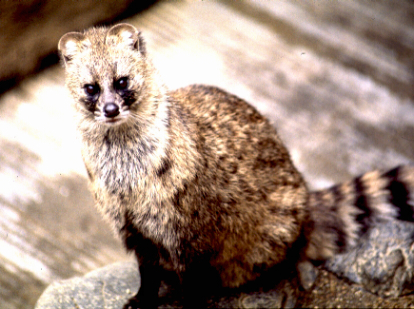
Small Indian civet(Viverricula indica, or Viverricula malaccensis)
Phylum —chordata
Class — mammalia
Order — carnivora
Family — viverridae
Genus—viverricula
Appearance
The Small Indian civet has a rather coarse fur that is brownish grey to pale yellowish brown, with usually several longitudinal black or brown bands on the back and longitudinal rows of spots on the sides. Usually there are five or six distinct bands on the back and four or five rows of spots on each side. Some have indistinct lines and spots, with the dorsal bands wanting. Generally, there are two dark stripes from behind the ear to the shoulders, and often a third in front, crossing the throat. Its underfur is brown or grey, often grey on the upper parts of the body and brown on the lower. The grey hairs on the upper parts are often tipped with black. The head is grey or brownish grey, the chin often brown. The ears are short and rounded with a dusky mark behind each ear, and one in front of each eye. The feet are brown or black. Its tail has alternating black and whitish rings, seven to nine of each color. It is 21–23 in (53–58 cm) from head to body with a 15–17 in (38–43 cm) long tapering tail.
Habitat
Small Indian civets occur in most of India, Sri Lanka, Myanmar, Thailand, Lao PDR, Cambodia, Viet Nam, south and central China, Pakistan, Bhutan, Bangladesh, Peninsular Malaysia, and Nepal.
Behavior
Small Indian civets are nocturnal and mostly terrestrial animals. Their homes are holes in the ground, under rocks or in thick bush. They can dig their own burrows, but also occupy abandoned burrows of other species. In suburban habitats, they use gutters or other hollow, dark spaces as makeshift burrows. In areas not disturbed by humans, these civets may sometimes hunt during the day. Small Indian civets spend most of the time on the ground but they also climb well. As they are solitary creatures the main way to communicate with each other is scent marking which also warns other Small Indian civets of territory boundaries.
Diet
Small Indian civets are carnivorous (insectivorous) animals that feed mainly on rats, mice, birds, snakes, and carrion. The may also eat fruit and roots. Some individuals were spotted while carrying off poultry.
Reproduction
In some areas, the breeding season can occur throughout the year while in other areas it's seasonal. Females usually give birth to 2-5 pups which are weaned at 4 to 4.5 months after birth.
The lifespan is eight to nine years.
In captivity
Civets are easily tamed in captivity, and even trained to go to the toilet. Their habits make them behave either a cat or a raccoon.
Ii is advisable after purchase, if the inguinal glands have not been removed, remove them at the local veterinary clinic, unless your house is turned into a perfume parlor.
If you want to make a manual civet, you need it to have daily contact with you.
So that it does not cause destruction around the house, it is better to find a few toys for the civet which she will be allowed to play. If the area allows, it is better to allocate a separate room for the civet.
It's better to feed it only chicken and fruit.
 Russian
Russian
 English
English
























